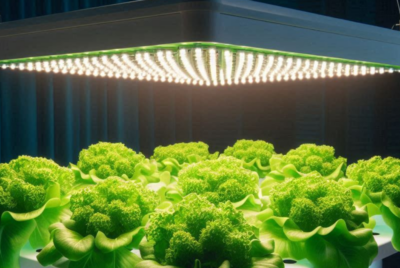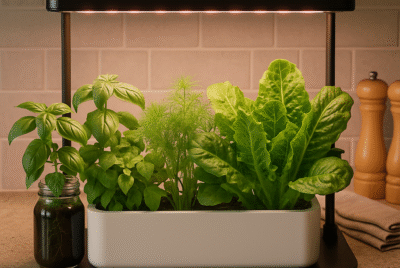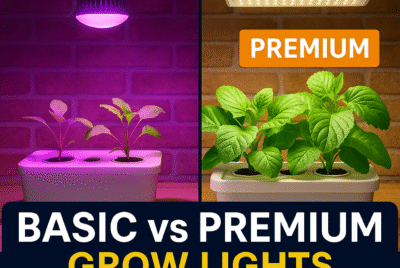The Ultimate Guide to Choosing the Best Hydroponic System
Introduction
Welcome to the exciting world of hydroponics, where gardening takes on a whole new dimension. In this section, we’ll set the stage for your hydroponic journey by exploring the fundamentals and showcasing the advantages of hydroponic gardening. We’ll also emphasize the critical aspect of choosing the right hydroponic system that suits your unique needs.
The Hydroponic Advantage
Hydroponics is a method of cultivating plants without soil, relying on a nutrient-rich water solution to nourish the roots. What makes this approach so fascinating is the multitude of benefits it offers to gardeners.
The ongoing advancements in this field, detailed in a comprehensive article by Valentina Lagomarsino and Rebecca Senft from Harvard University, shed light on the promise and challenges associated with this innovative farming method. Explore the full details in their insightful piece Hydroponics: The power of water to grow food
Increased Growth Rates
One of the primary advantages of hydroponics is the remarkable boost in plant growth. In a soilless environment, plants can focus their energy on upward growth rather than searching for nutrients in the soil. This results in faster development and higher yields.
Water Efficiency
Hydroponics is an incredibly water-efficient gardening method. Compared to traditional soil gardening, it can use up to 90% less water, making it a sustainable choice, especially in regions with water scarcity.
Space Utilization
Hydroponic systems are versatile and adaptable, making them ideal for urban gardeners or those with limited space. Vertical setups, for example, maximize the use of space, allowing you to grow more in less square footage.
The Right System Matters
While the advantages of hydroponics are clear, it’s equally crucial to emphasize that choosing the right hydroponic system is the key to success in this endeavor. Here are some tips to consider:
Assess Your Space
Before you dive in, assess the space you have available. Different hydroponic systems require different footprints. If you’re working with a small balcony, a compact system like a Kratky setup might be the perfect fit. For larger spaces, consider more extensive systems like Deep Water Culture (DWC).
Budget Considerations
Budget is another vital factor. Hydroponic systems can vary in cost, so it’s essential to set a budget that aligns with your financial situation. Remember that while initial investment may seem higher, the long-term savings in water and improved yields can make it a wise investment.
Your Experience Level
Consider your experience as a gardener. Some systems, like Nutrient Film Technique (NFT), are more suitable for experienced gardeners due to their complexity. If you’re a beginner, starting with a simpler system like the Kratky method can be less overwhelming.
Crop Preferences
Think about the type of crops you want to grow. Certain systems are better suited for specific plants. For example, nutrient-hungry crops like tomatoes may thrive in a DWC system, while leafy greens can do well in a Wick system.
By keeping these factors in mind, you’ll be better equipped to make an informed decision when choosing the best hydroponic system for your needs. In the following sections, we’ll delve deeper into the various hydroponic systems available and help you understand which one might be your best fit.
Understanding Hydroponic Systems
In this section, we’ll embark on a fascinating journey to explore the world of hydroponic systems. We’ll start by unraveling what hydroponic systems are, then take a closer look at various types, and discuss the advantages and disadvantages of each. By the end of this section, you’ll have a solid grasp of the hydroponic landscape.
What Are Hydroponic Systems?
Hydroponic systems represent a revolutionary approach to gardening, where plants grow without the need for soil. Instead, they rely on a nutrient-rich water solution to receive essential elements. Here’s a fundamental breakdown of how hydroponic systems work:
Soilless Cultivation
The core principle of hydroponics is soilless cultivation. Instead of planting in traditional soil, plants are anchored in inert growing mediums like rock wool, coconut coir, or even air. The primary source of nourishment for these plants comes from a meticulously balanced nutrient solution that is delivered directly to their roots.
Precision Control
Hydroponic systems allow for precise control over the growing environment. This means you can adjust the pH levels, nutrient concentrations, and even the light exposure to meet the exact needs of your plants. This level of control leads to accelerated growth and higher yields.
Types of Hydroponic Systems
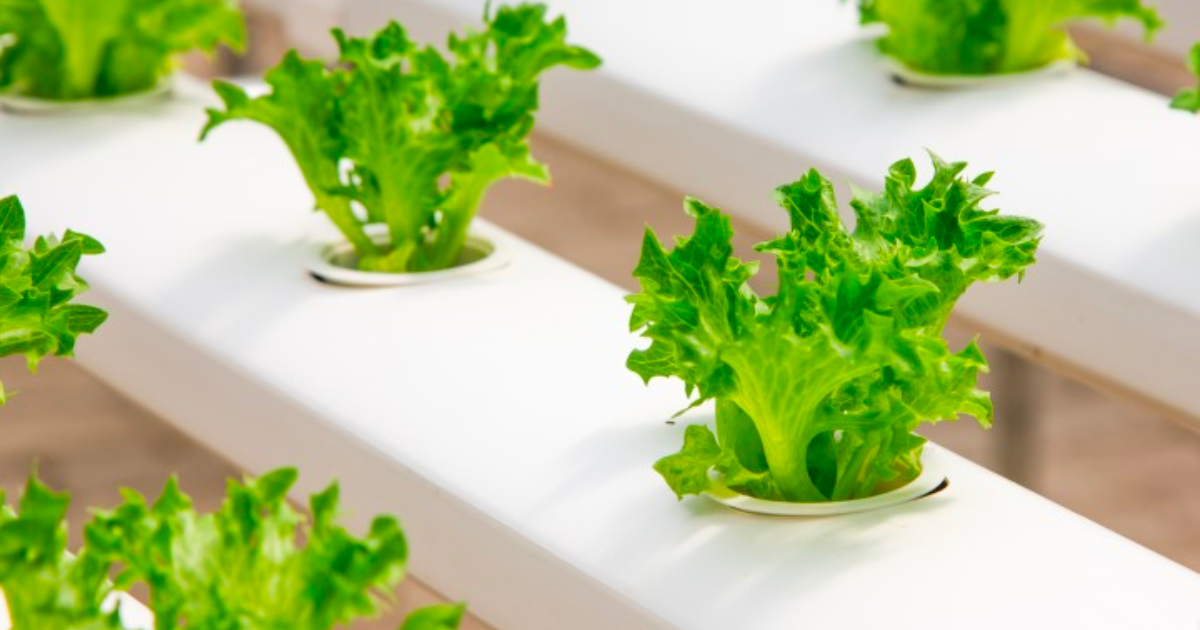
Now that you understand the core concept, let’s explore the various types of hydroponic systems, each with its unique characteristics:
Drip System
Pros:
– Highly versatile and can be used for a wide range of plants.
– Reduces the risk of overwatering, making it efficient in water usage.
– Good for larger gardens and commercial setups.
Cons:
– Requires regular maintenance to prevent clogging.
– Initial setup can be complex for beginners.
Deep Water Culture (DWC)
Pros:
– Excellent for fast-growing plants.
– Plants are suspended in nutrient-rich water.
– Minimal substrate usage reduces the risk of pests.
Cons:
– May require more initial investment.
– Can be challenging for beginners due to the need for constant monitoring.
Nutrient Film Technique (NFT)
Pros:
– Efficient use of water and nutrients.
– Ideal for smaller spaces due to its compact design.
– Suitable for experienced gardeners.
Cons:
– Less forgiving of errors; it requires careful monitoring.
– Not suitable for larger or heavy fruiting plants.
The Kratky Method
The Kratky method is a simplified form of hydroponics, making it a perfect choice for beginners. It’s passive, meaning it requires minimal equipment and maintenance. It’s an excellent choice for growing herbs, lettuce, and other small plants.
Wick System
The Wick system is another beginner-friendly option. It employs a wick to transport the nutrient solution to the plants’ roots. This method is highly efficient in water usage and requires minimal attention.
By exploring these various hydroponic systems, you can choose the one that best aligns with your gardening goals, experience, and the types of plants you want to cultivate.
In the following sections, we will dive deeper into each of these systems, providing detailed insights and guidance to help you make an informed decision.
Factors to Consider
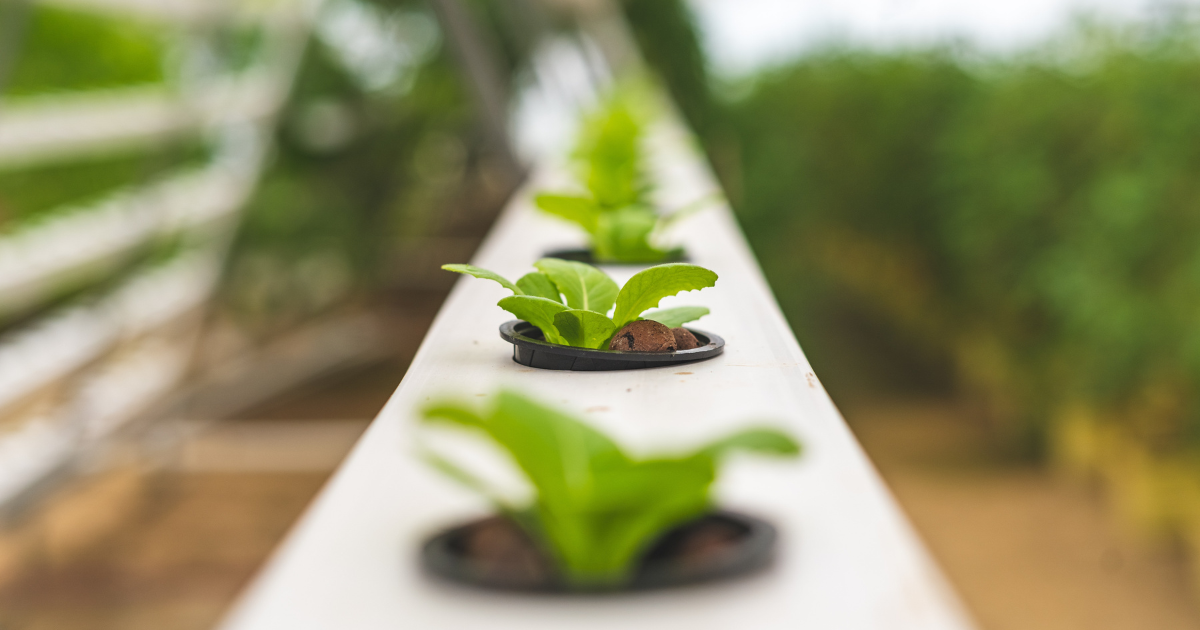
Selecting the right hydroponic system isn’t a one-size-fits-all decision. To make an informed choice, there are several crucial factors to consider. In this section, we’ll break down these considerations and provide you with a handy checklist to guide you in choosing the perfect hydroponic system for your needs.
Available Space
Your available space is one of the most significant determinants of the hydroponic system you can adopt. Consider the following:
Indoor vs. Outdoor
– Indoor Gardening: If you’re working with limited space indoors, compact systems like the NFT or Kratky method might be more suitable. They require less space and are perfect for apartment dwellers.
– Outdoor Gardening: If you have ample outdoor space, larger systems like Deep Water Culture (DWC) or nutrient film technique (NFT) can be considered. These systems require more room but often result in higher yields.
Vertical Gardening
Vertical gardening is an ingenious way to maximize space. Systems like vertical NFT or tower gardens are excellent for this purpose, enabling you to grow more in a smaller footprint.
Budget Considerations
Your budget plays a crucial role in determining the type of hydroponic system you can invest in. Here’s what to think about:
Initial Investment
Some hydroponic systems have higher initial setup costs due to equipment and technology requirements. Deep Water Culture (DWC) and aeroponic systems are examples of setups that may require a more substantial upfront investment.
Long-term Savings
Consider the long-term savings. Hydroponic systems are often more efficient in water usage and can lead to higher yields, ultimately saving you money over time.
Experience Level
Your experience as a gardener is another vital factor to consider:
Beginner-Friendly Systems
If you’re new to hydroponics, it’s advisable to start with a beginner-friendly system like the Kratky method or a Wick system. These require less maintenance and are less complex, making them a perfect choice for novices.
Advanced Systems
Experienced gardeners might opt for more complex systems like DWC or NFT. While these can be more challenging to set up and maintain, they offer the potential for larger yields.
Crop Preferences
Consider the types of plants you want to grow:
Leafy Greens and Herbs
If you’re focused on leafy greens or herbs, systems like NFT or the Kratky method work exceptionally well.
Fruit-Bearing Plants
For plants that bear fruits or require more nutrients, consider Deep Water Culture (DWC) or aeroponic systems.
Checklist for Choosing Your Hydroponic System
To help you make an informed decision, here’s a checklist:
1. Assess Available Space: Measure the space you have, whether indoor or outdoor, and choose a system that fits.
2. Determine Your Budget: Set a budget that aligns with your financial situation and long-term goals.
3. Evaluate Your Experience: Consider your level of expertise as a gardener and choose a system that matches your skills.
4. Identify Crop Preferences: Think about the types of plants you want to grow and select a system that’s suitable for those specific crops.
5. Consider Maintenance: Evaluate the amount of time you can dedicate to system maintenance. Some systems require more attention than others.
By taking these factors into account and using the checklist provided, you’ll be well-equipped to choose the ideal hydroponic system that aligns with your goals, resources, and gardening expertise.
In the following sections, we’ll dive into the specifics of various hydroponic systems to provide even more insights to aid in your decision-making process.
The Best Hydroponic Systems
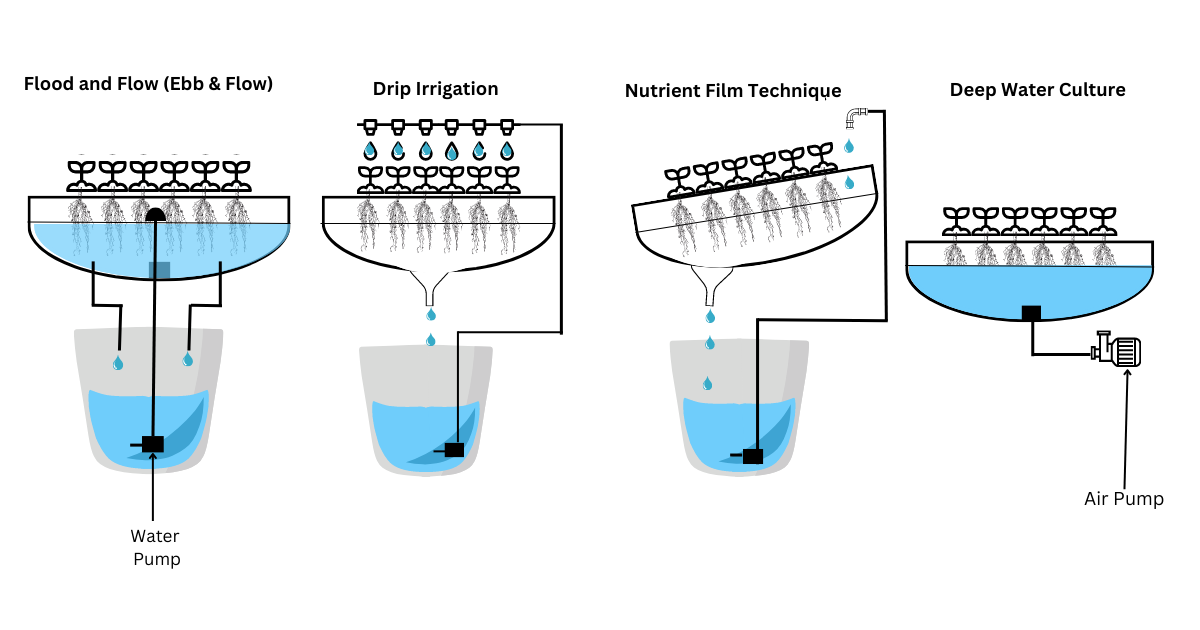
When it comes to hydroponics, the choices can be overwhelming. In this section, we’ll break down three of the best hydroponic systems: Deep Water Culture (DWC), Nutrient Film Technique (NFT), and Drip Systems. We’ll explain how each system works, discuss their advantages and disadvantages, and offer recommendations for potential users.
Deep Water Culture (DWC)
How DWC Works
Deep Water Culture, often referred to as DWC, is a hydroponic system where plant roots are submerged in a nutrient solution 24/7. Here’s how it works:
– Oxygenation: The plant roots are suspended in aerated water, ensuring they receive a constant supply of oxygen and nutrients.
– Buoyant Support: Plants are anchored in net pots filled with an inert medium like hydroton. These pots float on the nutrient solution.
Advantages of DWC
DWC is favored by many hydroponic enthusiasts due to its numerous benefits:
– Rapid Growth: The constant access to nutrients and oxygen leads to fast growth and robust yields.
– Minimal Medium: DWC doesn’t require soil or a lot of growing medium, reducing costs and maintenance.
– Pest Resistance: Submerging roots in water reduces the risk of soil-borne pests.
Disadvantages of DWC
Despite its advantages, DWC has its downsides:
– Complex Setup: Setting up a DWC system can be more intricate, particularly for beginners.
– Ongoing Maintenance: Continuous monitoring and maintenance are necessary to ensure oxygen levels are sufficient.
Personal Insights
DWC is a favorite among experienced hydroponic gardeners. It’s an ideal choice for those seeking maximum growth and yields. However, it’s crucial to be diligent in maintaining proper oxygen levels for the roots. Personal tip: Use air stones and check them regularly to ensure your plants thrive.
Nutrient Film Technique (NFT)
How NFT Works
Nutrient Film Technique (NFT) is a hydroponic system where a thin film of nutrient-rich water flows through a sloped channel. Here’s how it operates:
– Constant Flow: A shallow stream of water containing nutrients is continuously circulated over the plant roots.
– Capillary Action: Plants draw in the solution through capillary action, taking up the required nutrients.
Comparing NFT to Other Systems
NFT has unique characteristics that set it apart from other systems:
– Space-Efficient: NFT is space-efficient and is often chosen for indoor or limited space gardening.
– Moderate Maintenance: It falls between DWC and Drip Systems in terms of maintenance, making it suitable for those with some hydroponic experience.
Recommendations Based on Experience
For those with limited space or moderate hydroponic experience, NFT is an excellent choice. It combines efficient nutrient delivery with manageable maintenance. However, it’s essential to monitor the flow of the nutrient solution regularly to avoid any interruptions.
Drip Systems
Concept of Drip Systems
Drip systems are among the most commonly used hydroponic systems. They work by delivering a controlled amount of nutrient solution directly to the plant roots.
Here’s how they function:
– Drip Emitters: A network of drip emitters supplies a precise amount of nutrient solution to each plant, ensuring consistent nourishment.
– Recirculation: Excess solution is collected and recirculated, minimizing waste.
Benefits and Drawbacks of Drip Systems
Drip systems offer their unique advantages and disadvantages:
Benefits:
– Versatility: Suitable for various plant types.
– Water Efficiency: Minimizes water wastage.
– Scalability: Easily adaptable to different garden sizes.
Drawbacks:
– Clogging Risk: Drip emitters can clog, requiring regular maintenance.
– Initial Setup: Setting up a drip system can be more complex than other beginner-friendly methods.
Advice for Potential Users
Drip systems are an excellent choice for those looking for a versatile and efficient hydroponic solution. However, be prepared for regular maintenance to prevent clogs and ensure uninterrupted nutrient delivery. Ensure your system has proper filtration to reduce the risk of clogging.
In the following sections, we’ll explore more hydroponic systems, helping you make the right choice for your gardening aspirations.
Setting Up Your Hydroponic System
Congratulations on choosing to embark on your hydroponic journey. Setting up your hydroponic system is a rewarding and exciting process. In this section, we’ll provide you with a step-by-step guide on how to set up your hydroponic system. We’ll also include valuable tips on maintaining it for optimal growth and success.
Step 1: Gather Your Materials
Before you dive into the setup, make sure you have all the necessary materials and equipment. Depending on your chosen hydroponic system, this may include:
– Reservoir or container for the nutrient solution.
– Growing trays or pots.
– Growing medium (hydroton, coconut coir, rock wool, etc.).
– Pumps and tubing (if applicable).
– pH and EC meters for monitoring nutrient levels.
– Nutrient solution tailored to your plants.
– Proper lighting, if you’re doing indoor hydroponics.
– Support structures, trellises, or nets for plant support.
Step 2: Prepare the Nutrient Solution
Start by preparing your nutrient solution according to the manufacturer’s instructions. Ensure the solution’s pH and EC levels are within the optimal range for your chosen plants. Regularly check and adjust these levels as necessary to maintain plant health.
Step 3: Set Up the Growing Medium
If you’re using a system that requires a growing medium like hydroton, fill your growing trays or pots with it. Make sure it’s evenly distributed and leveled. The growing medium will anchor your plants and provide support.
Step 4: Plant Your Seeds or Seedlings
Carefully plant your seeds or seedlings in the growing medium. Ensure they are placed at the appropriate depth and spacing, following the guidelines for your specific crops. Be gentle to avoid damaging the delicate roots.
Step 5: Set Up the Irrigation System
If your hydroponic system requires an irrigation system, set it up to ensure a consistent supply of nutrient solution to your plants. Double-check that the flow rate and distribution are uniform across all plants.
Step 6: Provide Adequate Lighting
If you’re growing your plants indoors, ensure they receive proper lighting. Position your grow lights at the correct distance and duration for your plants’ needs. Be mindful of the light spectrum and intensity required during different growth stages.
Step 7: Monitor and Adjust
Consistent monitoring is key to success. Regularly check the pH and EC levels of your nutrient solution. Keep an eye on your plants for signs of nutrient deficiencies, pests, or diseases. Adjust the system and nutrient solution as needed to maintain optimal growing conditions.
Tips for Maintenance
Here are some additional tips for maintaining your hydroponic system:
– Cleanliness: Keep your system clean to prevent algae growth and clogs. Regularly clean and sanitize components like pumps and tubing.
– Pruning: Prune your plants as they grow to encourage airflow and prevent overcrowding.
– Nutrient Replenishment: Ensure you consistently replenish the nutrient solution to prevent nutrient deficiencies.
– Regular Inspections: Periodically inspect your system for any wear and tear. Replace any damaged components promptly.
– Record Keeping: Maintain records of your system’s performance, including pH and EC levels, plant growth, and any issues encountered. This data can help you make informed adjustments in the future.
By following these steps and staying vigilant in your maintenance efforts, you’ll be well on your way to a successful and thriving hydroponic garden. In the upcoming sections, we’ll provide further insights into maintaining your system and addressing common challenges.
Maintaining Your Hydroponic System
Your hydroponic garden, like any other, requires consistent care and maintenance to thrive. In this section, we’ll emphasize the critical importance of regular maintenance and provide you with essential tips on troubleshooting common issues that may arise in your hydroponic system.
The Importance of Regular Maintenance
Regular maintenance is the lifeblood of a successful hydroponic garden. Here’s why it’s so crucial:
1. Nutrient Balance:
Maintaining the correct balance of nutrients in your solution is vital for plant growth. Regular monitoring and adjustments ensure your plants receive the necessary elements for healthy development.
2. Preventing Clogs:
Over time, components like drip emitters or tubing can get clogged, disrupting the flow of the nutrient solution. Routine cleaning and inspection can help prevent clogs.
3. Pest and Disease Prevention:
By keeping a close eye on your plants and system, you can catch and address potential issues early, preventing the spread of pests and diseases.
4. Maximizing Yields:
Proper maintenance directly impacts your yield. Well-maintained systems lead to healthier plants and more abundant harvests.
Tips on Troubleshooting Common Issues
Now, let’s explore some common issues you might encounter in your hydroponic system and how to troubleshoot them effectively:
pH Imbalance:
– Issue: If you notice your plants are not thriving, check the pH levels of your nutrient solution. Deviations from the optimal pH range can affect nutrient uptake.
– Solution: Adjust the pH using pH-up or pH-down solutions to bring it back to the target range. Regularly monitor and maintain pH levels.
Nutrient Deficiencies
– Issue: Yellowing leaves or slow growth can be signs of nutrient deficiencies.
– Solution: Review the nutrient solution’s composition and adjust it to meet your plants’ specific needs. Consider using a balanced, hydroponic-specific nutrient mix.
Root Problems:
– Issue: Root rot or browning roots can harm your plants.
– Solution: Ensure good oxygenation in the root zone. Consider adding air stones to boost oxygen levels. Sterilize and replace any damaged or diseased roots.
Pest Infestations:
– Issue: Aphids, spider mites, or other pests can infiltrate your hydroponic garden.
– Solution: Introduce beneficial insects or use organic pest control methods. Isolate infected plants to prevent the spread.
Algae Growth:
– Issue: Algae can flourish in your nutrient solution or growing medium.
– Solution: Keep your system clean and avoid exposure to direct light. Consider using light-proof materials to prevent algae growth.
Temperature Fluctuations:
– Issue: Temperature swings can stress your plants and hinder growth.
– Solution: Maintain consistent temperatures in your grow area. Use climate control measures like fans, heaters, or cooling systems as needed.
Leakages or Drips:
– Issue: Leaks or inconsistent drips can lead to uneven watering and nutrient distribution.
– Solution: Check your system’s connections and ensure they are secure. Replace any damaged components. Regularly inspect for leaks.
Power Outages:
– Issue: Power outages can disrupt the operation of your system, affecting plants’ health.
– Solution: Consider backup power sources like battery-operated air pumps or generators to maintain oxygenation during outages.
By proactively addressing these common issues and performing regular maintenance, you’ll ensure the long-term success of your hydroponic system and enjoy a bountiful harvest year-round. In the upcoming sections, we’ll delve deeper into advanced maintenance techniques and provide answers to frequently asked questions to further assist you on your hydroponic journey.
Conclusion
In the world of hydroponics, possibilities bloom in the absence of soil, and cultivating plants becomes a remarkable, soilless adventure. As we near the end of this journey through hydroponic systems, it’s time to recap what we’ve learned and reinforce the pivotal significance of choosing the right system for your gardening ambitions.
Summarizing the Key Points
Throughout this article, we’ve explored the fascinating realm of hydroponics, from understanding the core principles to identifying the best hydroponic systems and considering essential factors. We’ve covered every aspect, from setting up your hydroponic system to maintaining it for thriving plants.
Here’s a brief recap of our key takeaways:
– Hydroponics is a soilless cultivation method that offers rapid growth, efficient water usage, and versatility in space utilization.
– Choosing the right hydroponic system is a decision influenced by factors like available space, budget, experience level, and crop preferences.
– Deep Water Culture (DWC), Nutrient Film Technique (NFT), and Drip Systems are among the best hydroponic systems, each with its unique advantages and disadvantages.
– Setting up a hydroponic system involves gathering materials, preparing the nutrient solution, setting up the growing medium, planting seeds or seedlings, and providing adequate lighting.
– Regular maintenance is paramount to hydroponic success, as it ensures nutrient balance, prevents clogs, and promotes healthy plants.
– Troubleshooting common issues like pH imbalances, nutrient deficiencies, root problems, and pests is essential to maintain optimal growing conditions.
The Importance of Choosing the Right System
As we conclude, we must underscore the pivotal role of selecting the right hydroponic system. Your choice determines the efficiency of your gardening venture, the health of your plants, and the magnitude of your harvests. The significance of this decision cannot be overstated.
Consider your available space, budget, experience level, and crop preferences diligently. Evaluate your commitment to maintenance and your capacity to address potential challenges. Armed with this knowledge, you can embark on your hydroponic journey with confidence, knowing that your choice aligns with your goals and resources.
Remember, hydroponics is not just a method; it’s a commitment to a greener, more efficient way of growing. It’s an opportunity to cultivate a diverse range of plants with remarkable growth rates and minimal environmental impact. The journey may have its challenges, but the rewards are bountiful.
As you take your first steps or continue your hydroponic journey, keep in mind that the right system is the foundation for a flourishing garden. It’s the key to vibrant, nutrient-rich harvests and a sustainable, enjoyable gardening experience. So, choose wisely and cultivate your way to a brighter, greener future.
In your hydroponic endeavor, may your plants thrive, your yields be plentiful, and your gardening journey be endlessly rewarding. Happy gardening!
FAQs
1. What is hydroponics, and how does it work?
Hydroponics is a soilless cultivation method where plants grow in a nutrient-rich water solution instead of soil. The plants receive essential nutrients directly to their roots, promoting faster growth and higher yields.
2. What are the advantages of hydroponic gardening?
Hydroponic gardening offers increased growth rates, water efficiency (up to 90% less water compared to soil gardening), and versatile space utilization, making it suitable for urban and limited-space environments.
3. How do I choose the right hydroponic system for my needs?
Consider factors such as available space, budget, experience level, and crop preferences. Systems like Deep Water Culture (DWC), Nutrient Film Technique (NFT), and Drip Systems each have unique characteristics suited for different situations.
4. What are the common issues in hydroponic systems, and how can they be addressed?
Common issues include pH imbalances, nutrient deficiencies, root problems, pests, algae growth, temperature fluctuations, leakages, and power outages. Regular maintenance, monitoring, and proactive troubleshooting are essential to address these issues effectively.
5. What steps are involved in setting up a hydroponic system?
Setting up a hydroponic system involves gathering materials, preparing the nutrient solution, setting up the growing medium, planting seeds or seedlings, setting up the irrigation system, providing adequate lighting, and consistent monitoring and adjustments.
*We may earn a commission from purchases made through our links, at no cost to you. This does not affect our product recommendations. Please see our disclosure to learn more.


